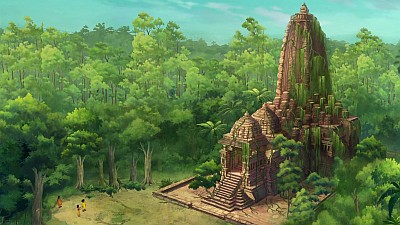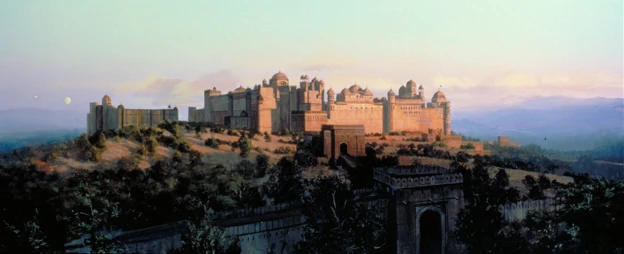Jump for joy!
Guess what? The show finally has been released with an english dub... in Australia. Thankfully the world is tied together with the internet so I was able to get my hand on them. Hopefully it won't be that long until the show gets a proper DVD release in the Europe. Still wonders why it took 2 years before it came into english. So I got to watch the whole season again since I need to see (or hear) what I missed.
Episode 1: Its funny how correct I was in my first watch through it. The only things I missed was that the fisher kids talk about the fact that they are forced by the law to turn them in to the local lord. Also, I didn't mention that Zia tells Tao that she also is a descendant of the people of Mu. And the documentary was more about the volcano that is still active today than about Japan in general as I gathered the first time. Also, Ambrosius handed over some kind of orichalcum matrix to the woman as well as Esteban's father. And by their discussion it seemed like they knew each other from before. Also, the fact that Zia can feel natural disasters before they happens are shown here the moment the condor falls into the water. Maybe I didn't notice it because it could just have been the birds and such flying away that warned her, but since it come up multiple times since then maybe it's something more to it. At least they are smart enough to say that it might just be a coincidence or it might actually be a real power, comparing it to Esteban's own sun calling abilities that might or might not be real. And it seems Mendoza's full name is Juan-Carlos Mendoza which he identified himself to the japanese.
Episode 2: Pretty much accurate this time as well. The water image didn't say anything special other than that the mirror shield was the key and apparently was supposed to be in the orichalcum capsule, but as Yoshi told the kids, was given to the lord of the lands that put it in the sacred temple at Izumo (I think its the place they are talking about). Also Ambrosius did indeed sell out Mendoza and Co as spies. The documentary was as described about the White Heron Castle and also about the fact that you have to take off your shoes in Japan... which is a strange thing to make notice of for a Swede that have the same custom. I know the Americans don't always do it, but does the french as well?
Episode 3: Nothing different really. It was clarified that the kids happened to fly over the field of rice with Mendoza and the others. What I don't get is the geography of the place. They start in Kagoshima that is almost the most south-western part of the country. They travel to Izumo that is north-east of there, but they somehow see Mt. Fuji which is even further east? That doesn't make sense really. So I checked where the mirror shield is located in real life, and it's supposed to be Isuzu and yes, it aligns better with Mt. Fuji and is probably in viewing distance since it is the highest mountain in Japan.
Episode 4: Another episode where the dialog really didn't matter so I got most of it the first time around.
Episode 5: I actually understood the riddle on the mirror shield and that the key was missing from its place on it this time around. Also the daiymons plans was a bit clearer in his aspiration for the shogunate and wanting Mendoza to hand over the Condor and the city of gold in order to achieve that, The documentary was cut in my original viewing of the show, but it was about the tea ceremony and a bit about the real temple that the mirror shield was hidden in together with a short bit about the existence of Kappa.
Episode 6: Understanding Gaspards motives are pretty interesting since it seems that he isn't that stupid. Since he knows the dayimon needs Mendoza he isn't willng to upset the lords plans by killing him. I like that. The documentary was about the smithing process of the katana, how they fold it and hammer it under running water while hot and so on and a small bit about the japanese clans different emblem and how they appears all over the place in buildings, clothing and what not.
Episode 7: Pretty much the same, probably due to it being action focused. The documentary was more about the sharpening of the katana and then it was more about the different parts of the katana.
Episode 8: Another action oriented scene. Most fun to listen to the insults Mendoza throws at Ambrosius during their duel. Also the documentary was about the scabbard of the katana and about Seki, a japanese city with workshops for the modern day katana-makers.
Episode 9: Apparently the inscription on the submarine was Thallios and Tao told everyone. Also the script on the statue at the third city was the name of that city, Soundgata or something like that. Googling it led me to
this wikipedia page about the founder of the Mali empire, the empire that had so much gold that it almost destabilised the economy of a country they visited on a pilgrimage (I think the legend goes). Now, I don't know if it was supposed to be that word or such, but that seems to be a huge coincidence. If that's true the city names have meaning beyond what I could imagine and have to go back to season 2 and find what the name was. I don't think the first city got a name beyond Eldorado, but I don't think that was its Mu-name. The documentary was about the real world inspiration of the rock formation that hide the city of gold and the discussion if they were man-made or natural phenomena. Also talked about the spider-crabs that attacked our heroes.
This concludes the recap of the first 9 episodes so then we're back to our normal viewing schedule, but without me complaining about not understanding what they are saying. I also gotta mention the voice acting. I still think that Esteban sounds more like a girl than a boy, but I'm probably getting used to them by now. And maybe that's the reason for the delay, since it sounds like the voice acting been tweeked and I don't know if its due to looking at a better version of the show, but the music sounds better. Just something I thought would be worth noting.



